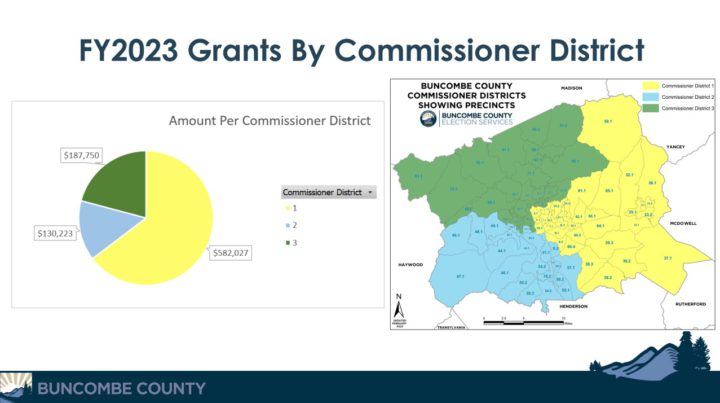Buncombe County voters haven’t yet authorized county government to issue up to $70 million in new debt; two referendums, for a $40 million housing bond and $30 million land conservation bond, aren’t on the ballot until November. But in anticipation of those votes, the county Board of Commissioners unanimously approved the creation of an oversight committee for the bond proceeds at its Aug. 16 meeting.
The resolution, presented by board Chair Brownie Newman with Commissioners Terri Wells and Amanda Edwards, would take effect if either or both of the bond referendums were approved. The oversight committee would monitor investments made with the bond money and ensure the funds were being used to meet Buncombe’s goals: conserve 20% of county land and increase affordable housing by up to 3,150 units, both by 2030.
The committee would be made up of five members. Four would be appointed by commissioners based on subject-matter expertise in accounting, banking, affordable housing and conservation or greenways. The final member, who would have no specific portfolio, would be appointed by the Asheville Area Chamber of Commerce. Members would serve until all bond funds had been committed, a process Newman said the county estimates will take seven years to complete.
In voting to establish the committee, several commissioners cited the need to build confidence and trust in the community. “I think this is just an extra step, that we want to show the community that we have this citizen oversight board to assure them that there is complete transparency and that they can feel confident that the funds are being spent in the way that they are stated and intended,” said Wells.
“Over the years, we have had several bond issuances in both the city and the county, and one of the complaints has been transparency,” added Commissioner Al Whitesides. “I think this helps that, because we have the overall committee to really look at it. This is one of the areas where we can’t have too many sets of eyes looking at it”
Other planned bond transparency measures were shared with the board during a June 7 presentation by Assistant County Manager Sybil Tate. In addition to the oversight committee, each bond will have a project manager responsible for maintaining a transparency website and reporting to commissioners and boards. A third-party audit will also be conducted annually.
Board discusses strategic partnership grants

Commissioners also heard an update from the Strategic Partnership Grant Committee during the Aug. 16 meeting. The committee reviews and makes recommendations for funding through the county’s Strategic Partnership Grants program, which supports nonprofit organizations that align with the four pillars of Buncombe’s strategic plan. Those focus areas are an educated and capable community, environmental and energy stewardship, resident well-being and creating a vibrant economy.
Committee member Annie Carpenter presented a breakdown of how much had been requested and awarded for each category for the current fiscal year. Out of more than $2.59 million in grant requests, the county had awarded $900,000, or about 35%.
Most applications fell into the category of resident well-being, which includes health and wellness, legal services, homelessness, mental health and violence prevention. Pisgah Legal Services received the largest overall award, at $80,000 of the $120,000 it requested. The category that received the least funding was environmental stewardship, although it was also the project area with the fewest applications.
The next application cycle will begin in December, but the committee will continue to meet year-round to monitor and support the nonprofits that were awarded grants. That includes site visits and quarterly performance reports, which will be published online at avl.mx/bxk.
Commissioner Wells, who represents the county’s District 1, recommended tracking the location of the impact of each grant award. The presentation included a geographic breakdown of the nonprofits receiving funds that showed that the majority were headquartered in District 1, which covers much of Buncombe’s eastern half. However, Wells suggested that the data didn’t necessarily show where the nonprofits would carry out their work.
“I think because of the way our districts are, if you just look at the districts, you’re not necessarily looking at the overall geographic dispersion,” said Wells. “Being able to look at where the impact of this grant is going to take place, and [if] are we actually touching all or a majority of our county rather than just specific locations — I think that is really important going forward.”
Carpenter said that the committee had discussed adding such an improvement to the grant process during its annual process review Aug. 4. Other suggested improvements included a “soft cap” to encourage applicants to keep their requests below $80,000, as well as weighted scoring to prioritize project budgets and plans separate from organizational capacity.




I get a little skeptical whenever I see the wiggle words “up to”, in this case, up to 3,150 units. As a voter, if you guaranteed me the 40 million you are asking voters to support would build that many housing units, I’d vote for it without a moment’s hesitation. But at those numbers, the average cost per unit is under $13,000. So what are we really talking about?